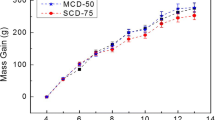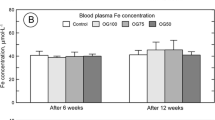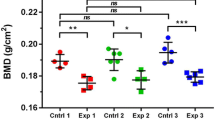Abstract
Two groups of weanling rats were maintained on diets containing an excess of zinc, with low calcium intake and with, or without, added vitamin D. Two thirds of the animals in the two groups were killed after five and ten weeks respectively while the remainder received these diets for five weeks and were then maintained for a further five weeks on the corresponding diets with a normal level of zinc. Histological and microradiographical observations of the humeri and incisors were then carried out. The known porotic effect of low calcium-normal vitamin D diets was markedly increased in zine excess. After adjusting the intake of zinc to normal, the degree of porosis was reduced to that typical of low calcium conditions, with little effect on the dentine. Absence of vitamin D from the zinc-low calcium diet resulted in both porotic and osteomalacic changes in the bones, while subsequent removal of the zinc excess resulted in a condition typical of osteomalacia. Dentine was drastically affected and, alternating bands of poorly and adequately-mineralized tissue were observed. Adjusting the zinc intake to normal resulted in wide seams of unmineralized dentine with a narrow band of mineralized tissue. In the absence of vitamin D, zinc excess appears to exert a porotic effect in bone and a mineralizing effect in dentine, while it also increases the degree of porosis found in bone when the vitamin is present.
Résumé
Deux groupes de rats sevrés sont soumis à une alimentation contenant un excès de zinc, une faible quantité de calcium avec ou sans vitamine D. Deux tiers des animaux dans les deux groupes sont sacrifiés respectivement après cinq et dix semaines, alors que les animaux restants sont soumis à ce régime pendant cinq semaines, puis, pendant les cinq semaines suivantes, reçoivent les régimes correspondants, avex une concentration normale de zinc. Des études histologiques et microradiographiques sont réalisées sur l'humérus et les incisives. L'effet porotique connu des régimes pauvres en calcium et normaux en vitamine D est notablement augmenté avec un excès de zinc. Après avoir ramené le zinc à la normale, la gravité de l'ostéoporose est réduite à celle recontrée au cours de concentration faible en calcium, avec peu d'effet sur la dentine. L'absence de vitamine D, dans les régimes à contenu élevé en zinc et faible en calcium, provoque des changements porotiques et ostéomalaciques des os, alors que le ratrait consécutif de l'excès de zinc provoque une ostéomalacie typique. La dentine est nettement atteinte et des bandes alternantes de tissus bien mal minéralisés sont observées. En ajustant le zinc ingéré à une concentration normale, de larges couches de dentine non minéralisée sont observées avec une bande étroite de tissu minéralisée. En l'absence de vitamine D, l'excès de zinc semble exercer un effet porotique sur l'os et un effet de minéralisation sur la dentine, alors qu'il augmente l'effet porotique au niveau de l'os lorsque la vitamine est présente.
Zusammenfassung
Zwei Gruppen entwöhnter Ratten wurden mit Calcium-armen Futter mit oder ohne Vitamin D-Zusatz und einem Zinküberschuß ernährt. Zwei Drittel der Tiere in beiden Gruppen wurden nach 5, beziehungsweise nach 10 Wochen getötet, während die übrigen Tiere dieses Futter während 5 Wochen erhielten und anschließend für weitere 5 Wochen die entsprechende Nahrung mit einem normalen Zinkgehalt bekamen. Die Humeri und die Schneidezähne wurden dann histologisch und mikroradiographisch untersucht. Der bekannte porotische Effekt der Calcium-armen, normal Vitamin D-haltigen Nahrung war bei Zinküberschuß deutlich erhöht. Wurde die Zinkaufnahme zur Norm gebracht, so reduzierte sich der Grad der Porose auf denjenigen, der typisch für niedrige Calcium-Einnahmen ist, mit wenig Wirkung auf das Dentin. Fehlte das Vitamin D in der Zink-reichen und Calcium-armen Nahrung, so entstanden in den Knochen sowohl porotische als auch osteomalazische Veränderungen; nach Absetzen des Zinküberschusses jedoch entstanden typische Anzeichen einer Osteomalacie. Das Dentin wurde stark angegriffen, und es wurden abwechslungsweise Banden von normal und schlecht mineralisiertem Gewebe beobachtet. Wenn die Zinkeinnahme zur Norm gebracht wurde, so entstanden breite Säume von unverkalktem Dentin mit einer schmalen Bande von mineralisiertem Gewebe. Bei Fehlen von Vitamin D scheint der Zinküberschuß eine porotische Wirkung auf den Knochen und eine verkalkende Wirkung auf das Dentin zu haben; dieser Überschuß erhöht den Grad der Knochenporose auch in Anwesenheit des Vitamins.
Similar content being viewed by others
References
Blunt, J. W., De Luca, H. F., Schnoes, H. K.: 25 Hydroxychole calciferol. A biologically active metabolite of vitamin D3. Biochemistry7, 3317–3322 (1968).
Brudevold, F., Steadman, L. T., Spinell, M. A., Amdur, H. H., Ron, P. G.: A study of zinc in human teeth. Arch. oral Biol.8, 135–144 (1963).
Cruickshank, D. B.: The natural occurrence of zinc in teeth. Preliminary experiments. Brit. dent. J.61, 530–531 (1936).
—: The natural occurrence of zinc in teeth. Some general considerations. Brit. dent. J.63, 395–399 (1937).
Ferguson, H. W., Hartles, R. L.: The effect of vitamin D on the bones of young rats receiving diets low in calcium or phosphorus. Arch. oral Biol.8, 407–418 (1963).
——: The effect of vitamin D on the dentine of the incisor teeth and on the alveolar bone of young rats maintained on diets defcient in calcium or phosphorus. Arch. oral Biol.9, 447–460 (1964).
Hartles, R. L., Leaver, A. G.: Citrate in mineralised tissues. III. The effect of purified diets low in calcium and vitamin D on the citrate content of the rat femur. Arch. oral Biol.5, 38–44 (1961).
Haussler, M. R., Myrtle, S. F., Norman, A. W.: The association of a metabolite of vitamin D3 with intestinal mucosa chromatinin vivo. J. biol. Chem.243, 4055–4064 (1968).
Huxley, H. G., Leaver, A. G.: The effect of different levels of dietary zinc and calcium upon the zinc concentration of the rat femur and incisor. Arch. oral Biol.11, 1337–1344 (1966).
Lawson, D. E. M., Wilson, P. W., Kodicek, E.: A new cholecalciferol metabolite, involving loss of H at C-1, in chick intestinal nuclei. Biochem. J.115, 269–277 (1969).
Leaver, A. G.: An effect of vitamin D upon the uptake and release of zinc by bone. Arch. oral Biol.12, 773–775 (1967).
Leaver, A. G.: Inter-relationships of calcium, phosphorus and vitamin D in the bones and teeth of the rat. Clin. Orthop. (1971 in press).
Reynolds, J. J., Dingle, J. T.: Time course of action of calcitonin on resorbing mouse bonesin vitro. Nature (Lond.)218, 1178–1179 (1968).
Sadasivan, V.: Studies on the biochemistry of zinc. 1. Effect of feeding zinc on the liver and bones of rats. Biochem. J.48, 527–530 (1951).
Samachson, J., Dennis, J., Fowler, R., Schmitz, A.: The reaction of65Zn with the surfaces of bone and bone mineral. Biochem. biophys. Acta (Amst.)148, 767–773 (1967).
Taylor, D. M.: Retention of65Zn in the bones of rats. Nature (Lond.)189, 932–933 (1961).
Author information
Authors and Affiliations
Rights and permissions
About this article
Cite this article
Ferguson, H.W., Leaver, A.G. The effects of diets high in zinc at different levels of calcium and vitamin D on the rat humerus and incisor. Calc. Tis Res. 8, 265–275 (1971). https://doi.org/10.1007/BF02010146
Received:
Accepted:
Issue Date:
DOI: https://doi.org/10.1007/BF02010146




